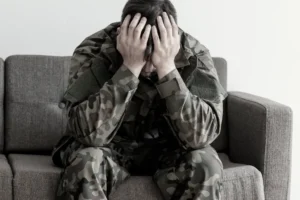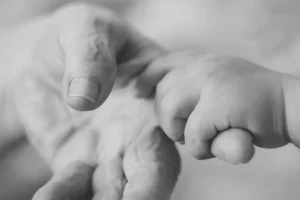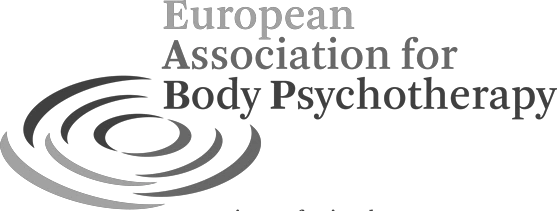Body Psychotherapy

What is Body Psychotherapy?
Body-oriented psychotherapy includes psychotherapy methods that work with both the psychological and physical dimensions of human experience and behaviour.
In body psychotherapy, body and psyche are considered together – emotions are developing in the body and in turn affect the body. Body awareness is seen as key for changing the emotional experiences. This is particularly important in body oriented trauma therapy.
Body psychotherapy uses a range of techniques and exercises to transform emotional experiences. These include body awareness, movement, tracking emotions and sensations, supportive touch and breathwork. This allows you to process emotional states stored in the body.
Body psychotherapy methods combine behavioral therapy, humanistic and depth psychology approaches and are therefore closely linked to other schools of therapy.
Overview Body Psychotherapy
Addressing the person as a whole
Basis of the psychotherapeutic relationship is good contact and trust between therapist and client. The basic stance of the therapist is in line with the person centric psychotherapy approach (Carl Rogers).
In the context of safe contact, the human being as a whole is addressed in four different dimensions:
Cognitive aspects (interpretation), physical aspects (movement, muscle awareness), body awareness (sensing awareness, mindfulness) and emotional aspects (emotion, reaction of the nervous system) are brought into consciousness together during a session and are therefore responsible for a transformation.
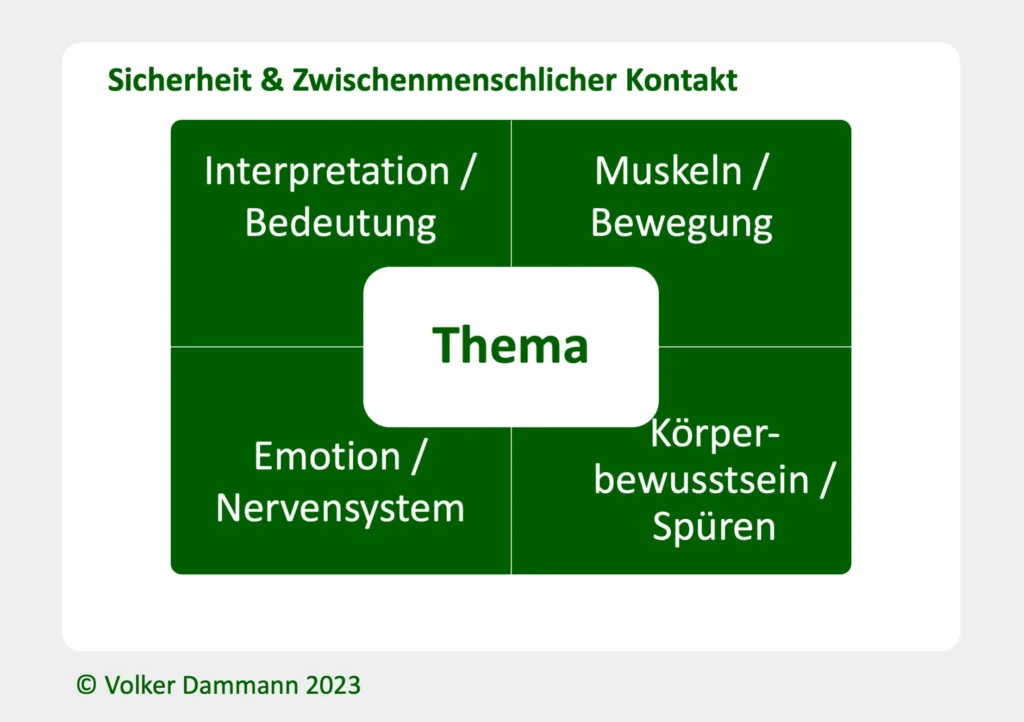
4-Dimensional Mindfulness in Contact
In body psychotherapy, people are treated holistically.
Advantages of Body Psychotherapy
Body psychotherapy is particularly suitable for psychosocial and psychosomatic phenomena that are less accessible to classic talk therapy. Body psychotherapy can therefore ideally complement cognitive-behavioural or psychodynamic approaches and plays an important role in trauma treatment.
Compared to other forms of psychotherapy, body psychotherapy has some particular strengths:
- Incorporating the body: Body psychotherapy recognizes the important role of the body in inner processes. Through the body (movement, impulses, sensations), emotions, thoughts and memories can be contained and transformed in a different way. You can gain a deeper understanding of emotions and thought patterns by becoming aware what happens in the body.
- Emotional self regulation: By working with the body, you can learn to regulate your emotions. Through techniques such as breathwork, movement, and touch, you can learn to regulate the nervous system and move through difficult emotions.
- Releasing and integrating trauma: Body psychotherapy is particularly effective in addressing trauma: Remnants of trauma energy are often stored in the body. Body psychotherapy can help releasing and processing these traumatic experiences. These physical expressions of trauma need to be processed in the body, purely cognitive approaches are usually not sufficient.
- Holistic approach: Body psychotherapy takes a holistic approach to healing. It recognizes that the mind and body are interconnected and that emotional issues can manifest in psychosomatic symptoms. Similarly, the body may contribute to emotional issues (somatopsychic symptoms). By addressing the whole person, body psychotherapy can help individuals achieve a greater sense of balance and well-being.
- Supporting body therapy approaches: Psychological aspects can create and maintain physical patterns – this can be explored in body psychotherapy. This is complementary to the bodywork of other therapeutic modalities. Unlike modalities such as massage or osteopathy, body psychotherapy does not use touch to directly alter the body.
Body-oriented psychotherapy methods are well suited to complement behavioral therapy and psychodynamic methods as well as body focused therapy approaches. Body-oriented methods play a special role in trauma therapy.
What happens during a body psychotherapy session?
Therapeutic work in body psychotherapy
In a body psychotherapy session, too, the topic is explored through conversations, with the focus being less on the content (memories, thoughts) and more on physical-emotional experiences. Body and mind are brought into contact in order to enable new experiences and behaviour. For this purpose, body-oriented psychotherapy methods use body perception, movement and exercises as an opportunity to literally set unconscious mental processes in motion and bring them into consciousness.
The specific procedures of body psychotherapy work in a present-oriented and experience-oriented manner. This means that the current emotional experience is brought into consciousness – through physical experience (feeling sensations and movement) change and emotional breakthroughs become possible.
Body psychotherapy focuses on emotional and body experiences and consciousness. Neither “physical exercise” nor “body work” take place. Muscle building, massages or fascia work fall into other therapeutic modalities.
Body Psychotherapy Exercises
In the framework of a safe therapeutic working alliance, the therapist supports the client with exercises to develop the client’s awareness for emotional and bodily experiences. This can be supported by the following:
- Exercises with contact – eye contact / attention / resistance
- Body awareness – feeling into your own body
- Breathing – being aware of ones breath and changing breathing patterns
- Movement and movement awareness – simple physical exercises (no fitness training)
- Self-touch to provide self-support
- Help and supportive touches (trauma sensitive)
- Directing attention towards certain body experiences
In body psychotherapy, the body gets involved in the psychotherapeutic process through exercises. In particular, we work with emotions, body sensing and movement.
Body Psychotherapeutic Methods
Body-oriented psychotherapy methods differ in approach from classic psychotherapy methods, such as cognitive behavioral therapy and psychodynamic methods, in which psychological issues are primarily addressed through language and consciousness.
In body-oriented therapy, we work a lot with the body, the awareness of sensation and movement, in addition to working with the waking consciousness.
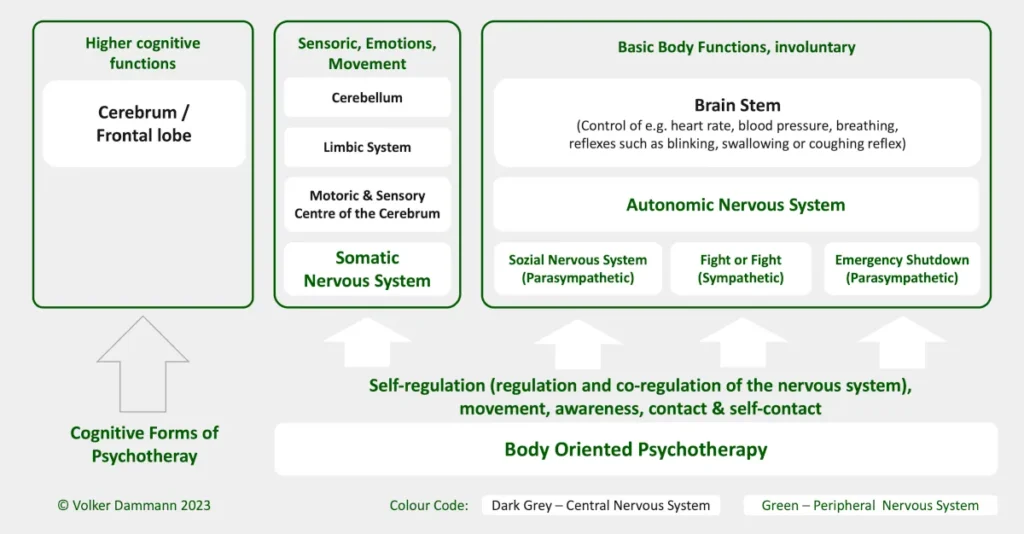
The additional tools of body psychotherapy address brain areas and nervous system components that are the links between the body and the cerebrum. This opens up additional potential for change that is difficult to achieve through language alone. This means that new insights become possible through working with the body.
Body psychotherapy works holistically. The body is integrated into the psychotherapeutic process through exercises. In particular, we work with sensitivity, movement and emotions.
Body Psychotherapy – Accessing Brain and Nervous System
Our psychological experience is not only shaped by our cerebrum (cognitive processing). Our limbic system (emotions), our brain stem (survival instincts) and our autonomic nervous system play a major role, especially when it comes to relationship issues and the processing of traumatic stress. However, these older brain and nervous system components are often difficult to access for conscious change work via cognitive processes or language. Working with the body bypasses kognitive rigidities and enables generative change.
By working with the somatic nervous system and the sensory and motor centers of the cerebrum, it becomes possible to reach the limbic system, the brainstem and the autonomic nervous system. This enables changes in conscious experience and lays the groundwork for further changes in “higher functions” such as thoughts, beliefs, and behavior.
The methods of body psychotherapy open up additional potential for change by working with the brain stem (instincts) and the autonomic nervous system.
Therapeutic Work: Discharging, Waking-up and Building Skills
In body-oriented psychotherapy, the autonomic nervous system is gently readjusted. By activating the social nervous system (good contact in therapy), it becomes possible to gently wake up areas of the body that are in emergency shutdown mode and discharge fight or flight reactions carefully.
Furthermore, the inclusion of the somatic nervous system makes it possible to build up concrete action skills. This is done by creating body awareness and practicing movements in contact. With the activation of the muscles, the psychological functionality is expanded at the same time. For this therapeutic exercises play a crucial role.
The simultaneous activation of the social and somatic nervous system enables the gentle post-processing of emotional stress and the gradual development of additional competence. This makes it possible to find a sustainable solution to psychological and social problems.
Complementary Approaches: Bodynamic® and Somatic Experiencing®
Emphasis of the different methods of Body Psychotherapy
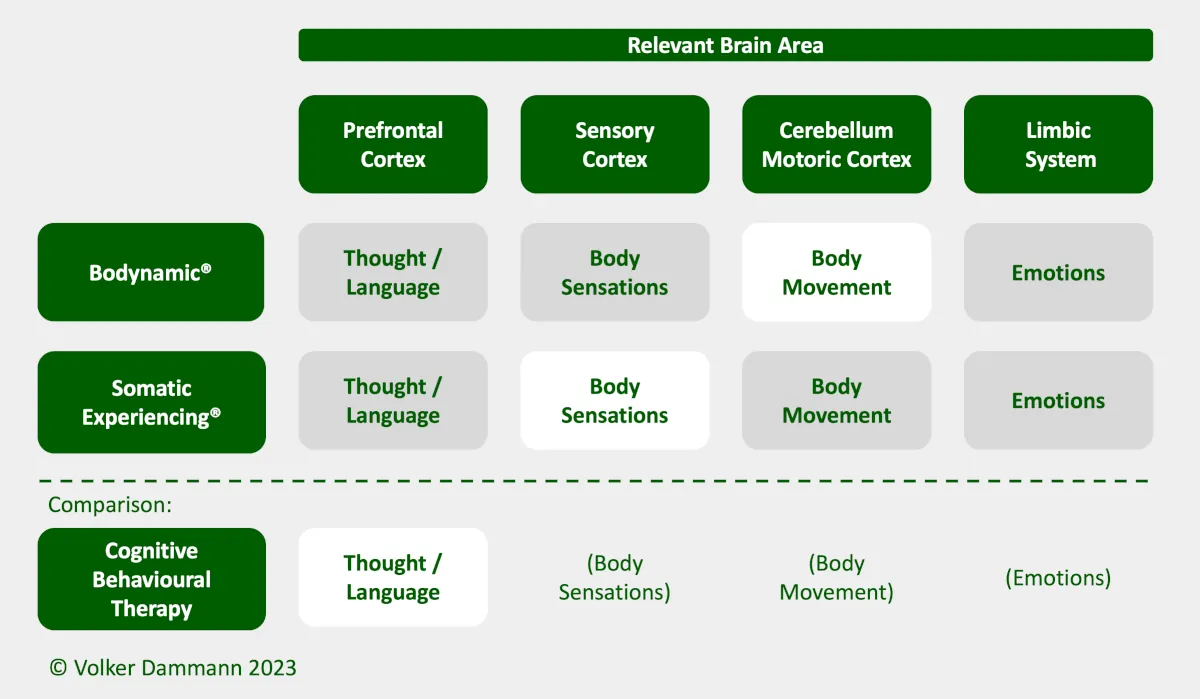
The various procedures have different priorities:
- Bodynamic has a special focus on activating muscles through movement and working with the muscular awareness. By working with the body, resources (possibilities of experiencing and behaving) are activated. This makes it possible to work with developmental trauma in particular.
- Somatic Experiencing has a particular focus on working with sensations and tracking states of activation throughout the body. The focus is on the gentle solution of shock trauma.
Note that in comparison, Cognitive Behavioral Therapy focuses on thoughts and language and less on body sensations, movement or emotions.
Somatic Experiencing and Bodynamic complement each other very well and together cover a wide range of body psychotherapeutic intervention options, including work with both shock and developmental trauma.
Comparison Bodynamic and Somatic Experiencing
Bodynamic
Emotional learning through working with movement, sensation and emotions
Focus of work in the brain / nervous system:
- Somatic Nervous System (muscles and movement)
- Sensory center (in the parietal lobe, near the frontal lobe)
- Motor center (in the frontal lobe)
- Cerebellum (cerebellum)
Somatic Experiencing
Trauma release by working with body sensations and emotions
Focus of work in the brain / nervous system:
- Autonomic nervous system (sympathetic & parasympathic branch)
- Sensory center (in the parietal lobe, near the frontal lobe)
- Amygdala (processing of emotions)
- Brainstem

